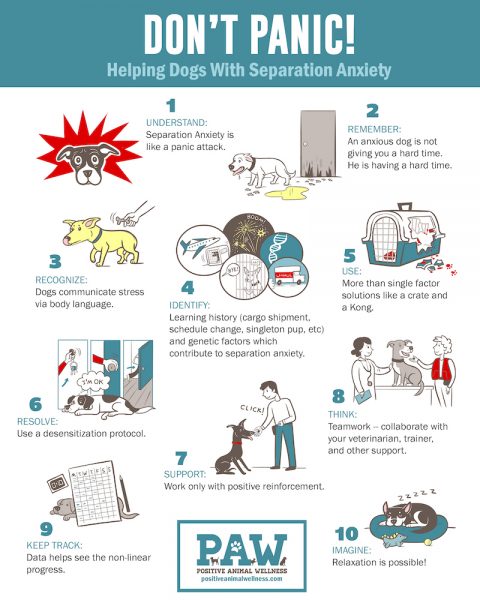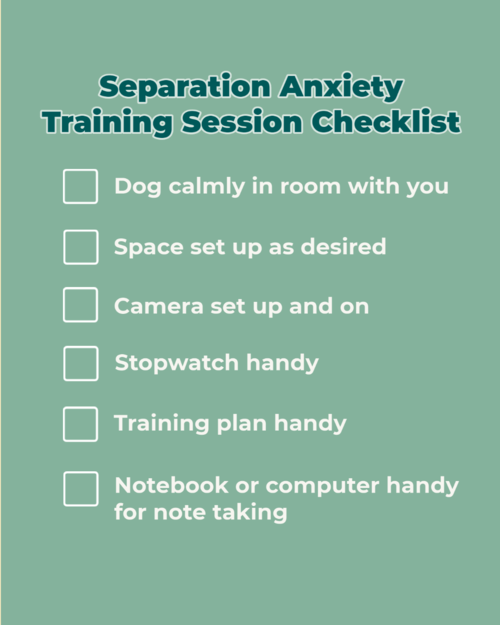Desensitization for separation anxiety in dogs involves slowly introducing alone time in easy-to-handle “bite-sized” steps to build a neutral association with your absence. This process should ideally begin when a dog is a young puppy and their brain is primed and ready to learn.
Separation anxiety in dogs can be a challenging issue for both pets and their owners. When dogs experience separation anxiety, they become distressed and anxious when left alone, often exhibiting destructive behavior or excessive barking. Desensitization is a behavioral technique that can help dogs overcome their separation anxiety by gradually exposing them to being alone in a controlled and positive way.
By following a systematic desensitization plan, you slowly introduce alone time in small increments, building a neutral association with your absence. This process helps dogs become more comfortable and confident when left alone, reducing their anxiety levels over time. Remember, desensitization for separation anxiety should be implemented gradually, taking into account the individual needs and limits of each dog. It is essential to be patient, consistent, and supportive throughout the process.

Credit: positiveanimalwellness.com
Understanding Separation Anxiety In Dogs
Desensitization is a crucial method for treating separation anxiety in dogs. By slowly introducing alone time in manageable steps, you can help your dog build a neutral association with your absence and alleviate their anxiety.
What Is Separation Anxiety?
Separation anxiety is a common behavioral issue that many dogs experience when they are left alone. It is characterized by extreme distress and fear when their owners are not present. Dogs with separation anxiety may exhibit inappropriate behavior, such as excessive barking, destructive chewing, or urinating in the house.
Common Symptoms Of Separation Anxiety
Dogs suffering from separation anxiety may display a range of symptoms, including:
- Panting and pacing: Dogs may exhibit anxious behavior by constantly moving, panting excessively, or restlessly roaming around the house in search of their owners.
- Destructive behavior: Chewing household items, scratching doors, or digging at carpets are common signs of separation anxiety. These behaviors are the result of the dog’s attempt to alleviate stress and find comfort.
- Excessive barking or howling: Dogs with separation anxiety often bark or howl excessively when left alone. This is their way of expressing distress and calling for their owners.
- Escaping attempts: Some dogs may try to escape from the house or crate in an attempt to find their owners. This can lead to injuries or damage to property.
- Changes in appetite and bathroom habits: Separation anxiety can impact a dog’s appetite and bathroom habits. They may refuse to eat or drink while alone or have accidents in the house due to stress.
Treating Separation Anxiety
Separation anxiety in dogs can be a distressing condition that affects both the dog and their owner. Fortunately, there are effective strategies to help alleviate separation anxiety in dogs. Two common treatment approaches are behavior modification and anxiolytic drug therapy.
Behavior Modification
Behavior modification is a method of training that aims to change the dog’s response to being alone. When it comes to treating separation anxiety, positive reinforcement with a twist can be a powerful tool. By rewarding your dog for calm and relaxed behavior, you can gradually desensitize them to the triggers of separation anxiety.
Crate training is another valuable technique in behavior modification. Introducing your dog to a crate and creating positive associations can provide them with a safe and secure space when you are away.
Independence training involves gradually increasing the amount of time your dog spends alone, helping them build confidence and reduce anxiety. This can be achieved by starting with short absences and gradually extending the time you are away.
Exercise and entertainment are key in managing separation anxiety. Ensuring your dog receives plenty of physical exercise and mental stimulation can help reduce their anxiety levels and keep them occupied in your absence.
Using an interactive camera allows you to keep an eye on your dog while you are away, providing reassurance and enabling you to interact with them remotely. Additionally, hiring a dog walker or sending your dog to doggy daycare can provide them with socialization and companionship, helping to reduce anxiety.
A flexible schedule can also be beneficial in managing separation anxiety. Structuring your day in a way that minimizes time apart from your dog can help reduce their anxiety levels.
In some cases, calming supplements or medications may be necessary to complement behavior modification techniques. Consult with your veterinarian to determine if this option is suitable for your dog.
Anxiolytic Drug Therapy
Anxiolytic drug therapy is another approach to treating separation anxiety in dogs. This type of therapy involves the use of medications that reduce anxiety and promote relaxation.
While behavior modification can be effective, anxiolytic drug therapy can often provide additional support and expedite the results. It is important to note that medication should always be administered under the guidance and supervision of a veterinarian.
By combining behavior modification techniques with anxiolytic drug therapy, you can increase the effectiveness of the treatment and improve your dog’s overall well-being.
Training Techniques For Desensitization
Desensitization is a powerful training technique that can help dogs overcome separation anxiety. By gradually exposing your dog to the triggers of their anxiety in a controlled manner, you can reduce their fear and build their confidence. Here are some effective techniques to implement desensitization training for separation anxiety in dogs.
Systematic Desensitization
Systematic desensitization involves exposing your dog to increasingly challenging situations that trigger their separation anxiety, in a gradual and controlled manner. This technique helps your dog become comfortable with being alone over time. Here’s how you can implement systematic desensitization:
- Start by identifying the specific triggers that cause your dog’s anxiety, such as picking up keys or putting on shoes.
- Once you have identified the triggers, create a hierarchy of these triggers based on the level of anxiety they provoke in your dog.
- Begin with the least anxiety-provoking trigger and repeatedly expose your dog to it, gradually increasing the duration and intensity of exposure.
- Once your dog is comfortable with the first trigger, move on to the next trigger in the hierarchy, continuing the process of gradual exposure.
- Repeat this process until your dog can tolerate being exposed to all triggers without experiencing anxiety.
Remember that consistency and patience are key when using systematic desensitization. It’s important to progress at a pace that is manageable for your dog and to celebrate their successes along the way.
Introducing Alone Time In Small Steps
Introducing alone time in small steps helps your dog gradually become accustomed to being alone. This technique can be particularly effective for dogs with severe separation anxiety. Here’s how you can introduce alone time in small steps:
- Start by leaving your dog alone for just a few seconds and then quickly returning.
- Gradually increase the duration of your absences, starting with increments of a few seconds and gradually working up to several minutes.
- Be sure to reward your dog for calm and relaxed behavior during your absences.
- If your dog becomes anxious during any step, go back to the previous step where they were comfortable and progress more slowly.
By gradually increasing the duration of alone time, your dog will learn that you always come back, which will help reduce their anxiety.
Implementing systematic desensitization and introducing alone time in small steps are effective techniques for desensitizing dogs with separation anxiety. These training methods require patience, consistency, and positive reinforcement to help your dog build confidence and overcome their fear of being alone.
Credit: www.pawslooklisten.com
Tips For Break A Dog’s Separation Anxiety
To desensitize a dog’s separation anxiety, try positive reinforcement with a twist, crate training, independence training, exercise, entertainment, an interactive camera, a dog walker or daycare, a flexible schedule, and calming supplements or medications. It may take around two months to desensitize a dog from separation anxiety.
Behavior modification and anxiolytic drug therapy can be effective treatments for separation anxiety in dogs. Plan your absences to be shorter than the time it takes for your dog to become upset, and gradually introduce alone time in manageable steps.
Positive Reinforcement With A Twist
One effective technique for breaking a dog’s separation anxiety is positive reinforcement with a twist. Instead of solely rewarding your dog for being calm when you leave or come back, try to create positive associations with your departure. For example, you can give your dog a special treat or toy that they only get when you leave. This will help them associate your departure with something enjoyable, rather than anxiety-inducing. Remember to use small, bite-sized treats or toys that your dog can easily chew or play with. Consistency is key here, so make sure to use this technique every time you leave.Crate Training
Crate training can be a valuable tool in treating separation anxiety in dogs. A crate provides a safe and secure space for your dog, simulating a den-like environment. Start by introducing your dog to the crate gradually, using positive reinforcement techniques. Leave the door open and encourage your dog to explore the crate on their own. Once they become comfortable, start closing the door for short periods while you’re still at home. Gradually increase the duration of time your dog spends in the crate, rewarding them for calm behavior. This will help your dog see the crate as a positive and comforting space, reducing their anxiety when you’re away.Independence Training
Independence training involves gradually increasing the amount of time your dog spends alone, starting from just a few minutes and gradually building up. Begin by leaving your dog alone for short periods in a safe and familiar space. Use positive reinforcement when your dog remains calm during these initial sessions. Over time, gradually increase the duration of time you’re away, making sure to reward your dog for calm and relaxed behavior. This training helps your dog develop confidence and independence, reducing their reliance on constant human presence.Exercise And Entertainment
Regular exercise and mental stimulation are crucial in managing separation anxiety in dogs. Make sure to provide your dog with plenty of physical exercise through walks, playtime, and interactive games. Mental stimulation can be achieved through puzzle toys, treat-dispensing toys, and training sessions. Engaging your dog in these activities before you leave can help tire them out, reducing their anxiety levels. Additionally, leaving them with interactive toys or long-lasting chews can provide mental stimulation and distraction while you’re away. A tired and mentally stimulated dog is more likely to feel calm and content during your absence.Calming Supplements Or Medications
In some cases, calming supplements or medications may be necessary to help manage a dog’s separation anxiety. These can be used in conjunction with training techniques, providing additional support. It’s important to consult with a veterinarian before starting any medication or supplement regimen to ensure safety and effectiveness. Natural supplements such as chamomile, valerian root, or CBD oil may help promote relaxation. Prescription medications, such as anti-anxiety drugs, may be recommended in severe cases. Always follow your veterinarian’s instructions and monitor your dog closely for any adverse reactions. By employing these tips, you can help break your dog’s separation anxiety and create a more relaxed and independent four-legged companion. Remember, each dog is unique, so it may take time and patience to find the right combination of techniques that work best for your furry friend. With consistency and positive reinforcement, you can help your dog overcome their separation anxiety and enjoy a happier, more balanced life.Timeframe For Desensitization
Desensitization for separation anxiety in dogs requires a timeframe of approximately two months. Taking it slow and gradually increasing the time of separation can help alleviate the anxiety. Positive reinforcement, crate training, exercise, and calming supplements can also be effective in treating separation anxiety.
How Long Does It Take?
Taking It Slowly During The Early Stages
Desensitization is a gradual process that helps dogs overcome separation anxiety. It is important to understand that each dog is unique, and the timeframe for desensitization can vary. However, on average, expect to spend around two months working with your dog to alleviate their anxiety.
Taking it slowly during the early stages is crucial for successful desensitization. The goal is to get your dog comfortable at the moment of your departure. By gradually introducing short periods of separation and gradually increasing the time away, you can help your dog adjust more quickly.
- Start by leaving your dog alone for just a few minutes.
- Gradually increase the duration of your absence over several training sessions.
- Observe your dog’s behavior and adjust the duration based on their comfort level.
- Use positive reinforcement, such as treats or toys, to reward your dog for remaining calm during your absence.
Remember to be patient and understanding throughout the desensitization process. Each small step forward is a step in the right direction towards helping your dog overcome separation anxiety.

Credit: www.tailsofconnection.com
Frequently Asked Questions On Desensitization For Separation Anxiety In Dogs
How Do You Break A Dog With Separation Anxiety?
To break a dog with separation anxiety, try positive reinforcement, crate training, independence training, exercise and entertainment, using an interactive camera, hiring a dog walker or providing doggy daycare, having a flexible schedule, and using calming supplements or medications. Expect to spend around two months desensitizing your dog to alleviate separation anxiety.
Behavior modification and anxiolytic drug therapy can also be effective treatments. Plan your absences to be shorter than the time it takes for your dog to become upset and gradually increase alone time in small increments.
How Long Does It Take To Desensitize A Dog Separation Anxiety?
Desensitizing a dog with separation anxiety can take around two months. Take it slow by getting your dog comfortable when you leave and gradually increase the time you spend away.
What Is The Most Effective Treatment For Separation Anxiety In Dogs?
The most effective treatment for separation anxiety in dogs is a combination of behavior modification and anxiolytic drug therapy. Behavior modification involves positive reinforcement, crate training, independence training, exercise, interactive cameras, dog walkers, and a flexible schedule. Anxiolytic drug therapy can aid in reducing anxiety and facilitate behavior modification.
Desensitization, gradually increasing the dog’s tolerance to being alone, is also a crucial component of treatment.
Can Separation Anxiety Be Trained Out Of A Dog?
Yes, separation anxiety can be trained out of a dog through a process known as desensitization. This involves gradually exposing the dog to being alone in small increments, building their tolerance over time. Other techniques include positive reinforcement, crate training, independence training, exercise, and calming supplements or medications.
Expect to spend around two months working with your dog to alleviate separation anxiety.
Conclusion
Desensitization is a crucial approach for treating separation anxiety in dogs. By slowly exposing the dog to the triggers of anxiety and gradually increasing their tolerance, we can help them become more comfortable being alone. This process requires patience and consistency, but the results can be incredibly rewarding.
Alongside behavior modification techniques and, in some cases, medication, desensitization offers a comprehensive approach to managing and reducing separation anxiety in our furry friends. Remember, it may take time, but with dedication, your dog can overcome their separation anxiety and lead a happier, more relaxed life.







